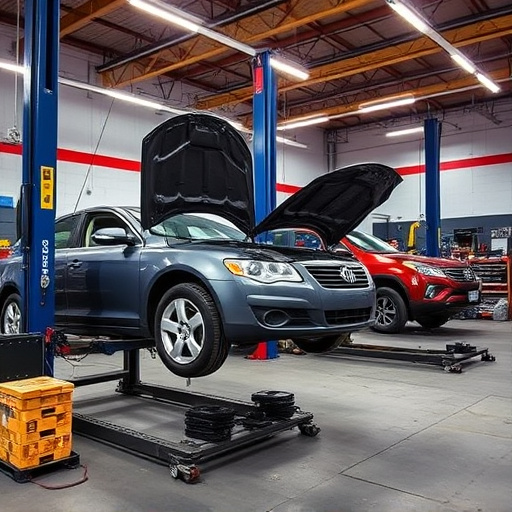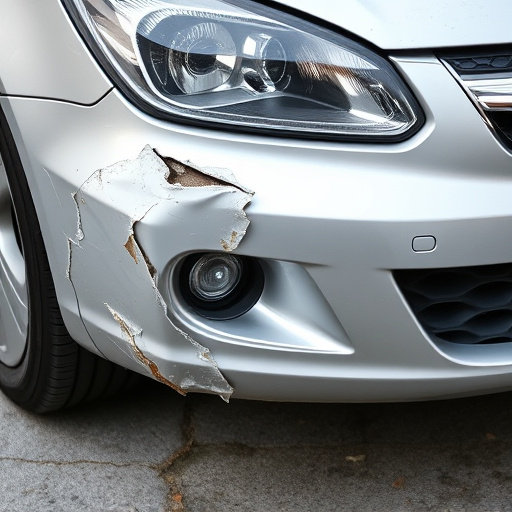Mercedes Electronic Stability Systems (ESS) are critical for vehicle safety, monitoring wheel speed and steering input to prevent skids or rolls. Regular maintenance and prompt repairs of any issues are crucial, as faulty electronics can affect both performance and safety. A reputable vehicle body shop specializing in car paint repair and advanced diagnostics is key to identifying and addressing ESS problems, ensuring your Mercedes remains a safe and reliable ride. After control module upgrades, meticulous repair processes are required to maintain optimal vehicle safety and performance, involving diagnostic testing, software updates, road testing, and final adjustments.
Mercedes vehicles are renowned for their advanced safety features, with electronic stability control (ESC) playing a pivotal role in preventing accidents. However, after control module updates, proper Mercedes electronic stability repair is crucial to maintain optimal performance and safety. This article delves into the intricate workings of Mercedes ESC systems, explores common issues arising from control module upgrades, and provides a step-by-step guide for repairs, ensuring your vehicle’s continued reliability and responsiveness.
- Understanding Mercedes Electronic Stability Systems: How They Work and Their Importance
- Common Issues and Updates: Why Control Module Upgrades Might Require Repair
- The Repair Process: Step-by-Step Guide to Ensuring Optimal Vehicle Safety and Performance After Updates
Understanding Mercedes Electronic Stability Systems: How They Work and Their Importance

Mercedes Electronic Stability Systems are a critical component of modern vehicle safety. These systems use sensors and actuators to monitor and control wheel speed, steering input, and other factors in real-time, helping to keep the vehicle stable and preventing skids or rolls. By detecting loss of control, the system can actively intervene through measures like individual wheel braking and traction control, often without the driver even realizing it. This proactive approach significantly enhances safety, especially during sudden maneuvers or adverse weather conditions.
Understanding how these systems work is essential when considering Mercedes electronic stability repair. After software updates, particularly for control module changes, it’s crucial to ensure these intricate mechanisms continue functioning optimally. Regular maintenance and prompt repairs of any issues are vital, as faulty electronics can compromise both vehicle performance and safety. A reputable vehicle body shop specializing in car paint repair and advanced diagnostics can play a critical role in identifying and addressing stability system problems, ensuring your Mercedes remains a safe and reliable ride.
Common Issues and Updates: Why Control Module Upgrades Might Require Repair

Mercedes vehicles are renowned for their advanced technology, but like any complex system, the control module—the brain of the electronic stability control (ESC) system—can experience issues over time. Control module upgrades are often necessary to fix common problems like sensor malfunctions or compatibility issues with new vehicle models. However, these updates might require a subsequent Mercedes electronic stability repair. This is because the ESC relies on precise calculations and real-time data from various sensors to maintain vehicle control. Any disruption in this delicate balance can lead to handling issues, increased risk of accidents, or even total loss of control.
While control module upgrades aim to enhance performance and safety, they can inadvertently introduce new challenges if not executed meticulously. For example, a faulty update might conflict with other vehicle systems, affecting braking, steering, or acceleration. Fortunately, many Mercedes dealers offer specialized services for these situations, including paintless dent repair and fender repair techniques, ensuring minimal car damage repair without compromising structural integrity or performance. These repairs are crucial in maintaining the vehicle’s stability control system, providing drivers with enhanced safety and peace of mind on the road.
The Repair Process: Step-by-Step Guide to Ensuring Optimal Vehicle Safety and Performance After Updates

After a Mercedes control module update, ensuring optimal vehicle safety and performance requires a meticulous Mercedes electronic stability repair process. The first step involves diagnosing any changes in the vehicle’s handling or stability following the update. This may involve a thorough inspection of the electronic stability control (ESC) system, including sensors, actuators, and wiring for any signs of damage or malfunction. If issues are detected, they must be rectified before proceeding.
The repair itself typically entails replacing the faulty control module or updating it with the latest software patch. Technicians should then conduct extensive road testing to verify that the ESC system functions correctly under various driving conditions. This includes scenarios mimicking emergency maneuvers and corners to ensure precise vehicle stability. Once confirmed, final adjustments can be made, ensuring not just optimal performance but also minimizing risks associated with vehicle collision repair. Regular auto maintenance checks post-repair are essential to maintain these safety standards.
After exploring the intricacies of Mercedes’ electronic stability systems, understanding their vital role in vehicle safety, and delving into common issues arising from control module updates, it’s clear that a meticulous repair process is essential. Any adjustments to the control module should be accompanied by a thorough inspection and necessary repairs to ensure optimal vehicle performance and safety. Investing in a Mercedes electronic stability repair guarantees that your vehicle navigates curves and challenges with precision and poise, offering peace of mind for every journey.













